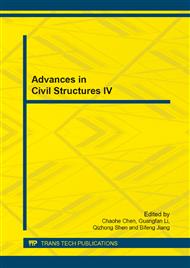p.417
p.422
p.427
p.432
p.441
p.445
p.456
p.460
p.464
An Experimental Evaluation of Development Length of Reinforcements Embedded in Geopolymer Concrete
Abstract:
Geopolymer concrete is an emerging construction material that uses a by-product material such as fly ash to completely replace the ordinary Portland cement. This material is being studied extensively and shows promise as a greener substitute for ordinary Portland cement. This paper evaluates the bond strength and development length of reinforcements embedded in geopolymer concrete with reinforcing steel using pull-out tests. The test according to EN 10080 was carried out on 27 specimens for three kinds of geopolymer concrete of 20, 30 and 40 MPa compressive strength and 10, 16 and 35 mm diameter reinforcing bars. The tests show that the bond strengths in geopolymer concrete were decreased as the diameter of reinforcement increased as in ordinary concrete and the values were greater than those in ordinary concrete. Also, the bond-slip curves were obtained which have similar shape with those of ordinary concrete. The equation for the determination of development length based on this experiment was proposed.
Info:
Periodical:
Pages:
441-444
Citation:
Online since:
July 2014
Authors:
Keywords:
Price:
Сopyright:
© 2014 Trans Tech Publications Ltd. All Rights Reserved
Share:
Citation:


